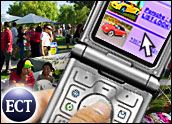
In the U.S., consumers are accustomed to paying for merchandise with checks, credit cards and debit cards. Online shopping and banking transactions are dependent on electronic money transfers between vendors and their customers’ financial institutions.

That experience, however, is not universal. Consumers in Europe and Asia are used to different types of systems. In some parts of the world, credit cards largely do not exist. In their place is the ubiquitous mobile phone, which serves as the conduit for payments.
Making online purchases with credit cards may seem convenient, but it can be just the opposite in certain circumstances. Entering a lengthy account number to make an in-game purchase can be a big hindrance in the heat of play, for example.
That’s what led David Marcus, CEO of Zong, to set up a system for subscribers to dial payments for digital content through their cellphone carriers with a four-digit authorization pin.
“We remove all the friction,” Marcus told the E-Commerce Times. “A purchase transaction takes 10 seconds to complete.”
Money Field
Zong is one of the first entrants into the pay-by-mobile space. The company’s transactions currently are limited to ringtones, games and device-specific programs.
The 9-year-old firm is integrated into 90 percent of the top 150 apps on Facebook and MySpace, and it has gone global via high-scale connectivity with more than 100 mobile carriers in 20 countries.
“Marcus is in a limited market involving payments for digital content,” said Bruce Cundiff, director of payments research and consulting for Javelin Strategy & Research.
“He has a leg up over competitors, because he is dealing directly with carriers. This is a plus for him. As long as that market holds, he’s sitting fat and happy,” Cundiff told the E-commerce Times.
Getting There
Although Zong is based in the U.S., Marcus tapped into the common practice in Europe and Asia of paying for things via mobile phones when he started the company some nine years ago.
He began mostly on his own, with help from some early backers and angel investors. Even though he has a techie background, he quickly discovered that he needed to hire engineers to develop the payment platform.
Also, his technical background was of little help in forging the kind of deals he would need to make. The business required more than engineering and technology.
Negotiating for the cooperation of many phone carriers was one of the biggest hurdles Marcus faced in getting his phone payment system to work. The challenges of accommodating many different languages and business systems were tricky, to say the least.
“This was difficult to set up. Phone carriers are notoriously very difficult to deal with,” Marcus remarked.
Near Failure
Most of Marcus’ early hurdles involved cultural fragmentation in Europe. He had to adapt to different customs and different phone carrier regulations each time he expanded into a new country.
“I soon experienced a sinking feeling about negotiating with dozens of carriers who used separate systems,” he recalled. “It was a very complex operation.” He found himself thinking that if he had to do it all over again, he would decide not to.
Early Success
After enduring what felt like a trip to hell and back, Marcus began making headway with the various European phone companies. His earliest success was winning a contract with Reuters to sell news alert subscriptions
Another early win was signing up a few European TV stations for voting. In Europe there is a huge difference in voting procedures, compared to the U.S.
Europeans can use any carrier to cast a vote for a small charge, he explained.
It was essential not only to develop multiple payment platforms for different monetary systems and languages, but also to build a system that could handle high throughput.
“I was processing 2,300 votes per [second at peak] per TV station,” said Marcus. [*Correction – Aug. 13, 2009]
Recent Partnerships
By 2007, Marcus was able to expand operations, offering Zong’s system to U.S. consumers.
On July 1, the company announced a partnership with Outspark, an onlinevirtual playground combining Freemium-based online games with personalized social experiences. Outspark community members can now use their mobile phones, via Zong’s mobile billing service, to purchase SparkCash, Outspark’s virtual currency.
Marcus inked another virtual success in mid July with teen virtual world Gaia Online. Gaia users now have the option to purchase the site’s virtual currency, Gaia Gold, with their mobile phone number and be billed by their mobile carrier.
These deals are the kinds of ongoing successes that Zong needs in order to grow out of its sales limitations. Marcus is adamant about maintaining his leadership position in the payment field.
“It is a huge developing market,” he noted.
What’s Next?
In the future, Marcus wants to expand beyond the more traditional payment market. He plans to venture into supporting mobile payments where none now exist.
Along the way, he will have to form new business models. One of those models would have him expanding into larger e-commerce and m-commerce arenas.
“This would involve customers who purchased store items having them billed to their cellphone bill instead of their credit card. This would be a big leap and would lower the margins for the phone carriers. It would also force the phone companies to carry much more credit than they do now,” said Javelin’s Cundiff.
A Big Leap
These expansion plans into broader sales markets could pose even more challenging negotiations with phone carriers. At present, no carrier is prepared to handle the higher credit risks.
“A big hurdle for Zong will be to convince carriers to accept lower margins. Carriers are used to 50 percent margins. They take half of the entire payment for an item. This will take some convincing and will not happen for a while,” suggested Cundiff.
Although its model for paying for digital content has been around for 10 to 12 years, Zong “is just coming into its own,” he concluded.
*ECT News Network editor’s note – Aug. 13, 2009: In our original published version of this article, we quoted Zong CEO David Marcus as saying the tally of votes processed was 2,300 per night per TV station. The correct figure is 2,300 votes per second at peak, Marcus told the E-Commerce Times by email on Aug. 13.
























































Social Media
See all Social Media